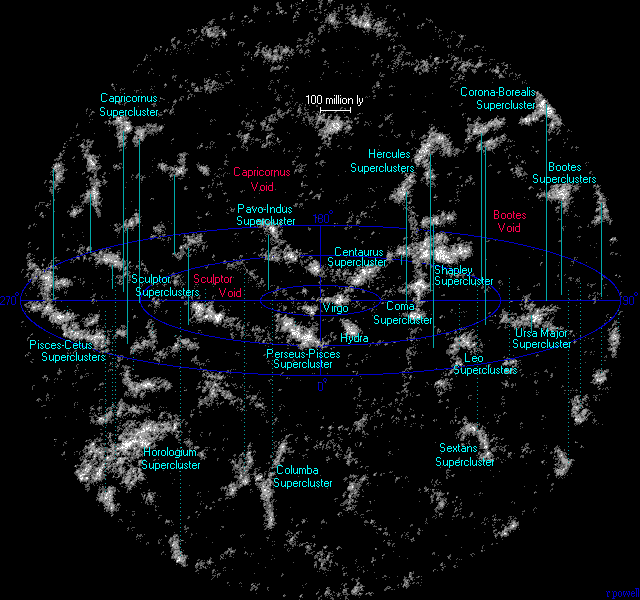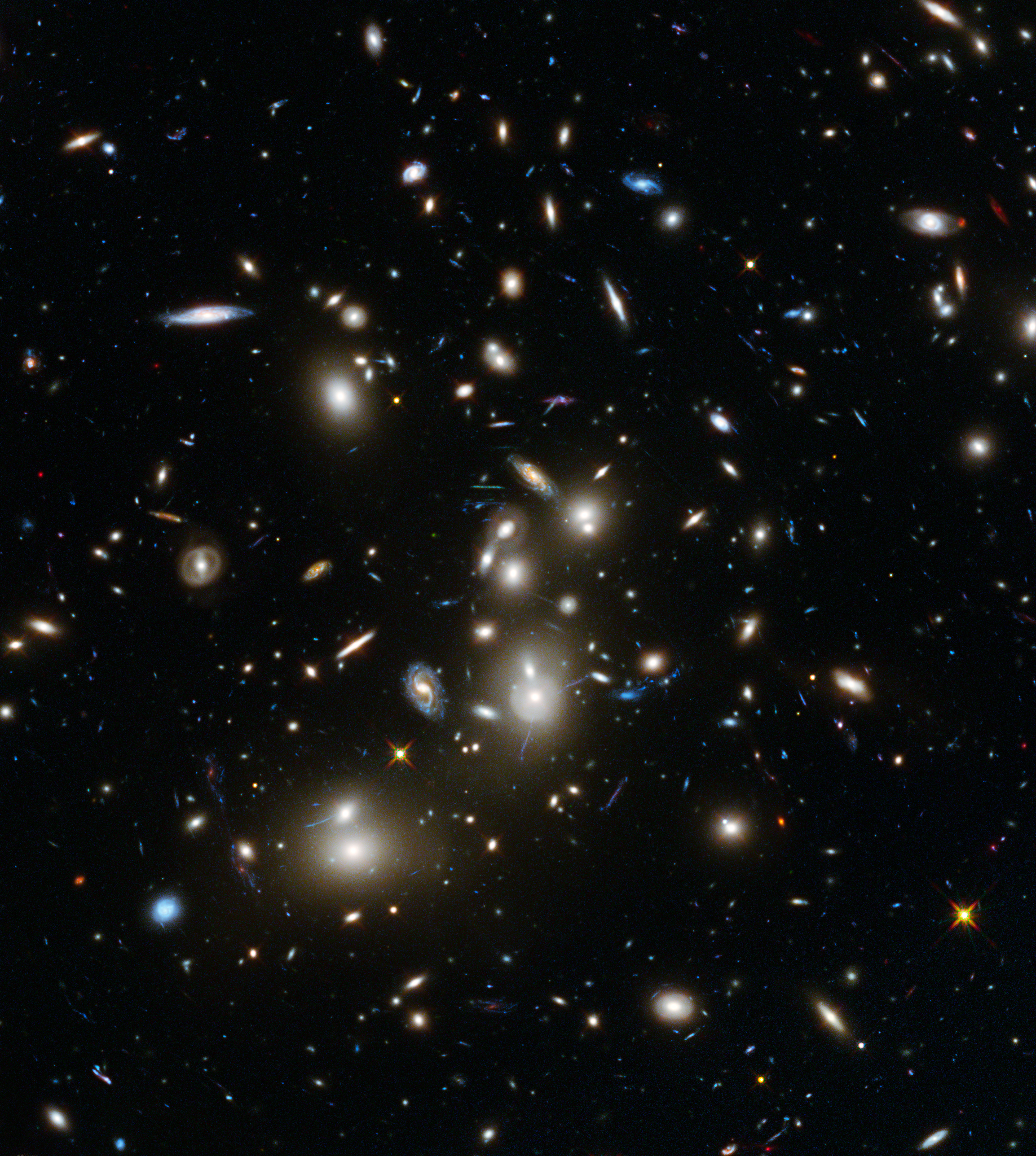|
Coma Supercluster
The Coma Supercluster (SCl 117) is a nearby supercluster of galaxies comprising the Coma Cluster (Abell 1656) and the Leo Cluster (Abell 1367). Located 300 million light-years from Earth, it is in the center of the Great Wall and a part of the Coma Filament. The Coma Supercluster is the nearest massive cluster of galaxies to our own Virgo Supercluster. It is roughly spherical, about 20 million light-years in diameter and contains more than 3,000 galaxies. It is located in the constellation Coma Berenices. Being one of the first superclusters to be discovered, the Coma Supercluster helped astronomers understand the large scale structure of the universe. See also * Abell catalogue * Large-scale structure of the universe * List of Abell clusters The Abell catalogue is a catalogue of approximately 4,000 galaxy clusters with at least 30 members, almost complete to a redshift of ''z'' = 0.2. It was originally compiled by the American astronomer George O. Abell in 1958 using plates ... [...More Info...] [...Related Items...] OR: [Wikipedia] [Google] [Baidu] |
Supercluster
A supercluster is a large group of smaller galaxy clusters or galaxy groups; they are among the largest known structures in the universe. The Milky Way is part of the Local Group galaxy group (which contains more than 54 galaxies), which in turn is part of the Virgo Supercluster, which is part of the Laniakea Supercluster."Earth's new address: 'Solar System, Milky Way, Laniakea ''Nature (journal), Nature'' The large size and low density of superclusters means that they, unlike clusters, expand with the Hubble expansion. The number of superclusters in the observable universe is estimated to be 10 million. Existence [...More Info...] [...Related Items...] OR: [Wikipedia] [Google] [Baidu] |
Virgo Supercluster
The Virgo Supercluster (Virgo SC) or the Local Supercluster (LSC or LS) is a mass concentration of galaxies containing the Virgo Cluster and Local Group, which itself contains the Milky Way and Andromeda galaxies, as well as others. At least 100 galaxy groups and clusters are located within its diameter of 33 megaparsecs (110 million light-years). The Virgo SC is one of about 10 million superclusters in the observable universe and is in the Pisces–Cetus Supercluster Complex, a galaxy filament. A 2014 study indicates that the Virgo Supercluster is only a lobe of an even greater supercluster, Laniakea, a larger, competing referent of the term Local Supercluster centered on the Great Attractor. Background Beginning with the first large sample of nebulae published by William and John Herschel in 1863, it was known that there is a marked excess of nebular fields in the constellation Virgo (near the north galactic pole). In the 1950s, French–American astronomer Gérard de Vau ... [...More Info...] [...Related Items...] OR: [Wikipedia] [Google] [Baidu] |
Leo (constellation)
Leo is one of the constellations of the zodiac, between Cancer (constellation), Cancer the crab to the west and Virgo (constellation), Virgo the maiden to the east. It is located in the Northern celestial hemisphere. Its name is Latin for lion, and to the ancient Greeks represented the Nemean Lion killed by the mythical Greek hero Heracles meaning 'Glory of Hera' (known to the ancient Romans as Hercules) as one of his Twelve Labours, twelve labors. Its old astronomical symbol is (♌︎). One of the 48 constellations described by the 2nd-century astronomer Ptolemy, Leo remains one of the 88 modern constellations today, and one of the most easily recognizable due to its many bright stars and a distinctive shape that is reminiscent of the crouching lion it depicts. The lion's mane and shoulders also form an asterism (astronomy), asterism known as "The Sickle," which to modern observers may resemble a backwards "question mark." Features Stars Leo contains many bright stars, many ... [...More Info...] [...Related Items...] OR: [Wikipedia] [Google] [Baidu] |
Coma Supercluster
The Coma Supercluster (SCl 117) is a nearby supercluster of galaxies comprising the Coma Cluster (Abell 1656) and the Leo Cluster (Abell 1367). Located 300 million light-years from Earth, it is in the center of the Great Wall and a part of the Coma Filament. The Coma Supercluster is the nearest massive cluster of galaxies to our own Virgo Supercluster. It is roughly spherical, about 20 million light-years in diameter and contains more than 3,000 galaxies. It is located in the constellation Coma Berenices. Being one of the first superclusters to be discovered, the Coma Supercluster helped astronomers understand the large scale structure of the universe. See also * Abell catalogue * Large-scale structure of the universe * List of Abell clusters The Abell catalogue is a catalogue of approximately 4,000 galaxy clusters with at least 30 members, almost complete to a redshift of ''z'' = 0.2. It was originally compiled by the American astronomer George O. Abell in 1958 using plates ... [...More Info...] [...Related Items...] OR: [Wikipedia] [Google] [Baidu] |
List Of Abell Clusters
The Abell catalogue is a catalogue of approximately 4,000 galaxy clusters with at least 30 members, almost complete to a redshift of ''z'' = 0.2. It was originally compiled by the American astronomer George O. Abell in 1958 using plates from POSS, and extended to the southern hemisphere by Abell, Corwin and Olowin in 1987. The name "Abell" is also commonly used as a designation for objects he compiled in a catalogue of 86 planetary nebulae in 1966. The proper designation for the galaxy clusters is ACO, as in "ACO 13", while the planetary-nebula designation is the single letter A, as in "A 39". 1–1999 2000–4076 Southern catalogue S1–S1174 See also * Lists of astronomical objects * List of galaxy groups and clusters This article lists some galaxy groups and galaxy clusters. Defining the limits of galaxy clusters is imprecise as many clusters are still forming. In particular, clusters close to the Milky Way tend to be classified as galaxy clusters eve ... [...More Info...] [...Related Items...] OR: [Wikipedia] [Google] [Baidu] |
Abell Catalogue
The Abell catalog of rich clusters of galaxies is an all-sky catalog of 4,073 rich galaxy clusters of nominal redshift ''z'' ≤ 0.2. This catalog supplements a revision of George O. Abell's original "Northern Survey" of 1958, which had only 2,712 clusters, with a further 1,361 clustersthe "Southern Survey" of 1989, published after Abell's death by co-authors Harold G. Corwin and Ronald P. Olowin from those parts of the south celestial hemisphere that had been omitted from the earlier survey. The Abell catalog, and especially its clusters, are of interest to amateur astronomers as challenge objects to be viewed in dark locations on large aperture amateur telescopes. The Northern Survey The original catalog of 2,712 rich clusters of galaxies was published in 1958 by George O. Abell (1927–1983), who was then studying at the California Institute of Technology. The catalog, which formed part of Abell's PhD thesis, was prepared by means of a visual inspection of th ... [...More Info...] [...Related Items...] OR: [Wikipedia] [Google] [Baidu] |
Observable Universe
The observable universe is a ball-shaped region of the universe comprising all matter that can be observed from Earth or its space-based telescopes and exploratory probes at the present time, because the electromagnetic radiation from these objects has had time to reach the Solar System and Earth since the beginning of the cosmological expansion. There may be 2 trillion galaxies in the observable universe, although that number was reduced in 2021 to only several hundred billion based on data from '' New Horizons''. Assuming the universe is isotropic, the distance to the edge of the observable universe is roughly the same in every direction. That is, the observable universe is a spherical region centered on the observer and is unique for every unique observational position. The word ''observable'' in this sense does not refer to the capability of modern technology to detect light or other information from an object, or whether there is anything to be detected. It refers to the ... [...More Info...] [...Related Items...] OR: [Wikipedia] [Google] [Baidu] |
Astronomer
An astronomer is a scientist in the field of astronomy who focuses their studies on a specific question or field outside the scope of Earth. They observe astronomical objects such as stars, planets, natural satellite, moons, comets and galaxy, galaxies – in either observational astronomy, observational (by analyzing the data) or theoretical astronomy. Examples of topics or fields astronomers study include planetary science, Sun, solar astronomy, the Star formation, origin or stellar evolution, evolution of stars, or the galaxy formation and evolution, formation of galaxies. A related but distinct subject is physical cosmology, which studies the Universe as a whole. Types Astronomers usually fall under either of two main types: observational astronomy, observational and theoretical astronomy, theoretical. Observational astronomers make direct observations of Astronomical object, celestial objects and analyze the data. In contrast, theoretical astronomers create and investigate C ... [...More Info...] [...Related Items...] OR: [Wikipedia] [Google] [Baidu] |
Coma Berenices
Coma Berenices is an ancient asterism in the northern sky, which has been defined as one of the 88 modern constellations. It is in the direction of the fourth galactic quadrant, between Leo and Boötes, and it is visible in both hemispheres. Its name means "Berenice's Hair" in Latin and refers to Queen Berenice II of Egypt, who sacrificed her long hair as a votive offering. It was introduced to Western astronomy during the third century BC by Conon of Samos and was further corroborated as a constellation by Gerardus Mercator and Tycho Brahe. It is the only modern constellation named for a historic person. The constellation's major stars are Alpha, Beta, and Gamma Comae Berenices. They form a half square, along the diagonal of which run Berenice's imaginary tresses, formed by the Coma Star Cluster. The constellation's brightest star is Beta Comae Berenices, a 4.2-magnitude main sequence star similar to the Sun. Coma Berenices contains the North Galactic Pole and one of the r ... [...More Info...] [...Related Items...] OR: [Wikipedia] [Google] [Baidu] |
Coma Filament
The Coma Filament is a galaxy filament. The filament contains the Coma Supercluster of galaxies and forms a part of the CfA2 Great Wall. See also * Abell catalogue * Large-scale structure of the universe * Supercluster A supercluster is a large group of smaller galaxy clusters or galaxy groups; they are among the largest known structures in the universe. The Milky Way is part of the Local Group galaxy group (which contains more than 54 galaxies), which in turn ... References Galaxy filaments Large-scale structure of the cosmos Astronomical objects discovered in 1985 {{physical-cosmology-stub ... [...More Info...] [...Related Items...] OR: [Wikipedia] [Google] [Baidu] |
Coma Berenices (constellation)
Coma Berenices is an ancient asterism in the northern sky, which has been defined as one of the 88 modern constellations. It is in the direction of the fourth galactic quadrant, between Leo and Boötes, and it is visible in both hemispheres. Its name means "Berenice's Hair" in Latin and refers to Queen Berenice II of Egypt, who sacrificed her long hair as a votive offering. It was introduced to Western astronomy during the third century BC by Conon of Samos and was further corroborated as a constellation by Gerardus Mercator and Tycho Brahe. It is the only modern constellation named for a historic person. The constellation's major stars are Alpha, Beta, and Gamma Comae Berenices. They form a half square, along the diagonal of which run Berenice's imaginary tresses, formed by the Coma Star Cluster. The constellation's brightest star is Beta Comae Berenices, a 4.2-magnitude main sequence star similar to the Sun. Coma Berenices contains the North Galactic Pole and one of the r ... [...More Info...] [...Related Items...] OR: [Wikipedia] [Google] [Baidu] |
CfA2 Great Wall
The Great Wall (also called Coma Wall), sometimes specifically referred to as the CfA2 Great Wall, is an immense galaxy filament. It is one of the largest known superstructures in the observable universe. This structure was discovered c. 1989 by a team of American astronomers led by Margaret J. Geller and John Huchra while analyzing data gathered by the second CfA Redshift Survey of the Center for Astrophysics Harvard & Smithsonian (CfA). Characteristics The term "Great" has been added to distinguish it as an even larger type compared to standard galaxy walls. Great walls are so rare that only five or possibly six (if the disputed Hercules–Corona Borealis Great Wall is counted) of them have been discovered to date. The CfA2 Great Wall has the maximum dimensions of either 500 million or 750 million light years depending on the figure and the reference used. It is 200 million light years in width and about 16 million light years in thickness. Its nearest point is about 30 ... [...More Info...] [...Related Items...] OR: [Wikipedia] [Google] [Baidu] |








